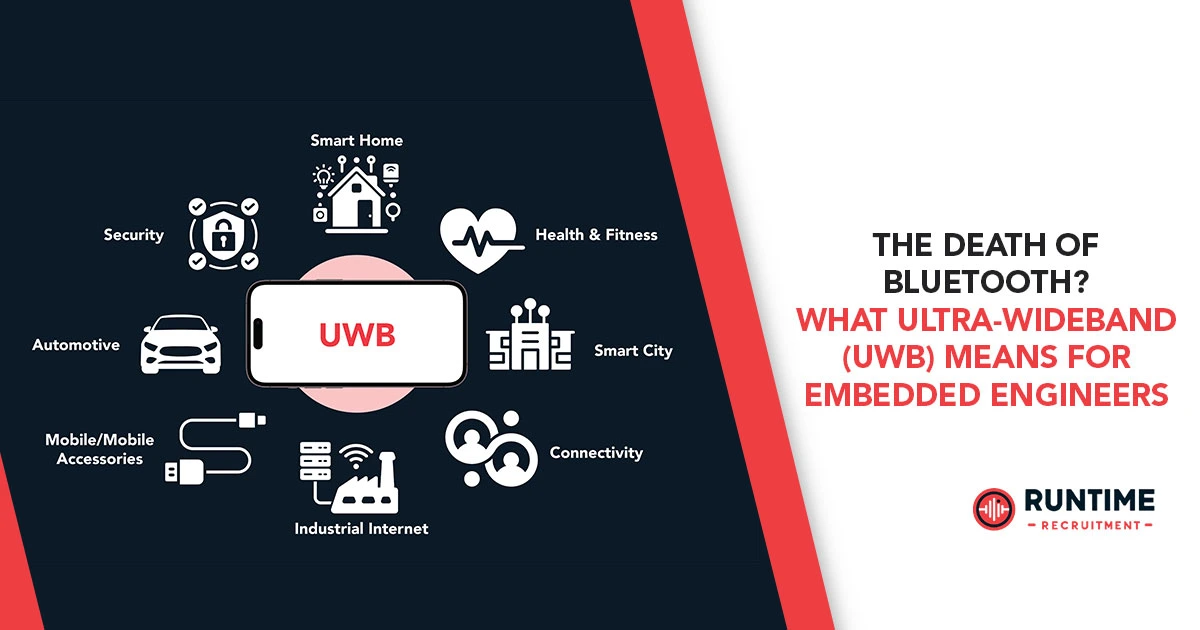For decades, Bluetooth has been the go-to wireless technology for short-range communication in embedded systems. From wireless headphones to IoT sensors, Bluetooth’s low power consumption, ease of use, and widespread adoption have made it a staple in embedded design. However, a new contender is emerging that could challenge Bluetooth’s dominance: Ultra-Wideband (UWB).
With its high precision, low latency, and secure ranging capabilities, UWB is gaining traction in applications where Bluetooth falls short—such as real-time location tracking, secure access control, and high-speed data transfer. But does this mean the death of Bluetooth? Or will the two technologies coexist, each serving different niches?
In this article, we’ll explore:
- The fundamental differences between UWB and Bluetooth
- Key advantages of UWB for embedded systems
- Current and future applications of UWB
- Whether Bluetooth is truly at risk of being replaced
- What embedded engineers need to know about adopting UWB
Bluetooth vs. UWB: A Technical Comparison
Before declaring Bluetooth dead, let’s compare the two technologies at a fundamental level.
1. Frequency & Bandwidth
- Bluetooth (Classic & BLE) operates in the 2.4 GHz ISM band with narrowband channels (1-2 MHz for BLE).
- UWB uses 3.1–10.6 GHz with 500 MHz+ wide channels, enabling high-precision time-of-flight (ToF) measurements.
2. Data Rate & Latency
- Bluetooth LE (BLE): ~1-2 Mbps (low data rate, optimized for power efficiency).
- UWB: Can reach hundreds of Mbps, with sub-nanosecond timing accuracy, making it ideal for real-time applications.
3. Power Consumption
- BLE is optimized for ultra-low power (years on a coin cell battery).
- UWB consumes more power but is still efficient for short bursts (e.g., ranging).
4. Range & Precision
- Bluetooth: ~10–100m (with variable precision in RSSI-based ranging).
- UWB: ~10–200m with cm-level accuracy due to ToF and angle-of-arrival (AoA) techniques.
5. Security
- Bluetooth has improved security (BLE 4.2+), but is still vulnerable to relay attacks.
- UWB is inherently secure against relay attacks due to time-based encryption.
Why UWB is a Game-Changer for Embedded Systems
1. Precision Ranging & Location Tracking
Bluetooth’s RSSI-based distance estimation is notoriously unreliable. UWB, on the other hand, provides cm-level accuracy, making it ideal for:
- Indoor navigation (hospitals, warehouses)
- Asset tracking (UWB tags on equipment)
- Autonomous robots & drones (precise collision avoidance)
2. Secure Access & Authentication
UWB’s time-of-flight measurements make it nearly impossible to spoof, enabling:
- Keyless car entry (Tesla, BMW, and others already use UWB)
- Secure building access (replacing NFC/RFID)
- Contactless payments (more secure than Bluetooth or NFC)
3. High-Speed, Low-Latency Data Transfer
While Bluetooth is sufficient for audio streaming, UWB can handle:
- Real-time video streaming (AR/VR headsets)
- Industrial automation (machine-to-machine communication)
- Wireless USB replacements (fast file transfers)
4. Better Coexistence in Crowded RF Environments
Bluetooth struggles in congested 2.4 GHz environments (Wi-Fi, Zigbee, etc.). UWB’s wideband signals are more resilient to interference.
Is Bluetooth Really Dead?
Despite UWB’s advantages, Bluetooth isn’t going away anytime soon. Here’s why:
1. Power Efficiency Still Favors BLE
For battery-operated IoT devices (wearables, sensors), BLE remains the best choice.
2. Cost & Ecosystem
Bluetooth chips are cheaper and more widely available than UWB solutions.
3. Backward Compatibility
Billions of Bluetooth devices exist—UWB adoption will take years.
4. Hybrid Solutions Are Emerging
Many devices (like smartphones) now include both Bluetooth and UWB (e.g., Apple’s U1 chip).
The Future: Coexistence, Not Replacement
Instead of killing Bluetooth, UWB will likely complement it:
- Bluetooth for low-power, general-purpose connectivity
- UWB for high-precision, secure, and high-speed applications
What Embedded Engineers Should Do Now
1. Evaluate Whether UWB Fits Your Use Case
- Do you need cm-level positioning? (UWB wins)
- Is ultra-low power the priority? (Stick with BLE)
2. Experiment with UWB Development Kits
- NXP’s Trimension™ UWB kits
- Qorvo’s DW3000-based modules
- Apple/Android UWB APIs for smartphone integration
3. Consider Hybrid Designs
Some applications (smart locks, asset trackers) may benefit from BLE for setup + UWB for ranging.
4. Watch the Standards Evolution
- IEEE 802.15.4z (UWB security enhancements)
- FiRa Consortium (promoting UWB interoperability)
Conclusion: The Rise of UWB, But Not the End of Bluetooth
UWB is undoubtedly a disruptive force in embedded wireless, offering unmatched precision, security, and speed for next-gen applications. However, Bluetooth’s low cost, power efficiency, and massive ecosystem ensure it will remain relevant for years to come.
For embedded engineers, the key takeaway is this: UWB is not a Bluetooth killer—it’s a powerful alternative for specific use cases. The future belongs to multi-radio devices that leverage the strengths of both technologies.
Further Reading & Resources
- FiRa Consortium: https://www.firaconsortium.org/
- IEEE 802.15.4z UWB Standard
- NXP UWB Solutions: https://www.nxp.com/UWB
- Qorvo DW3000 Datasheet









